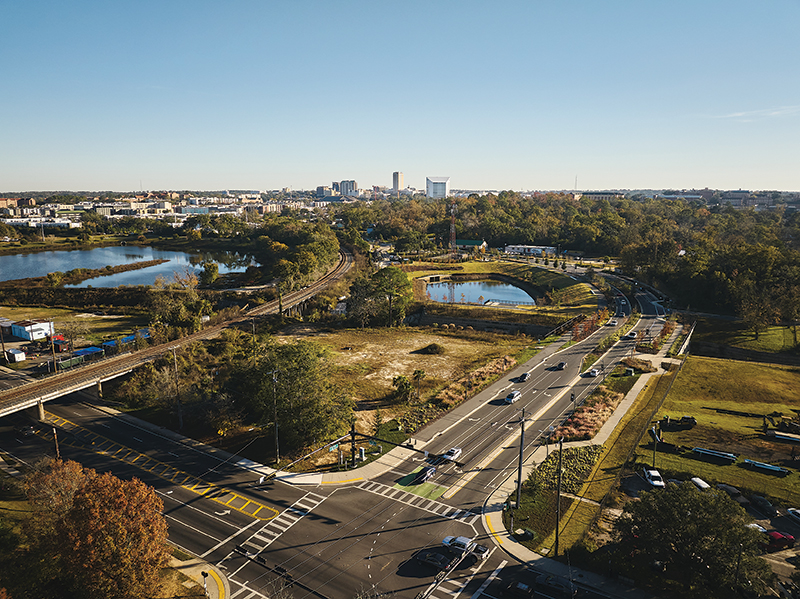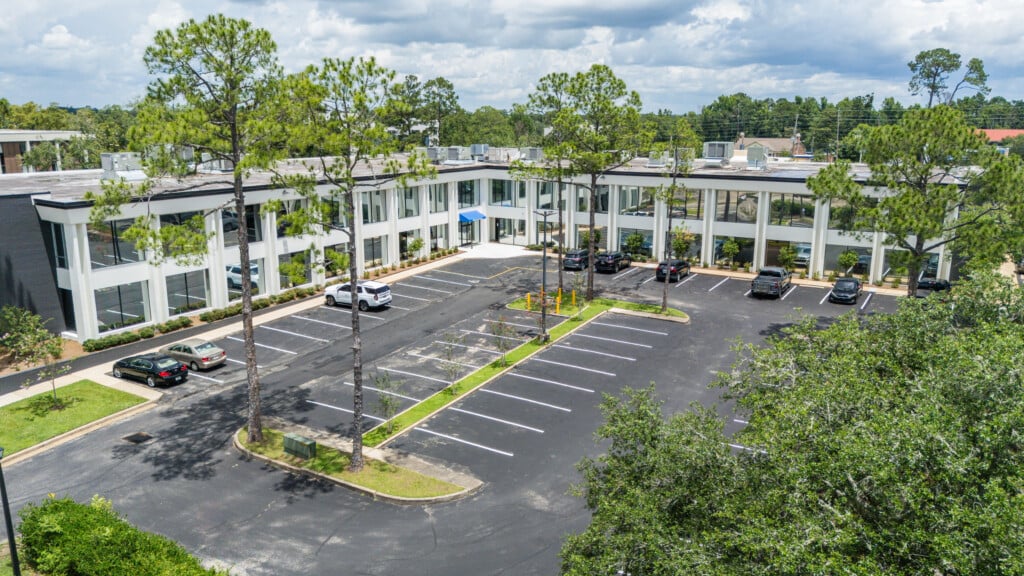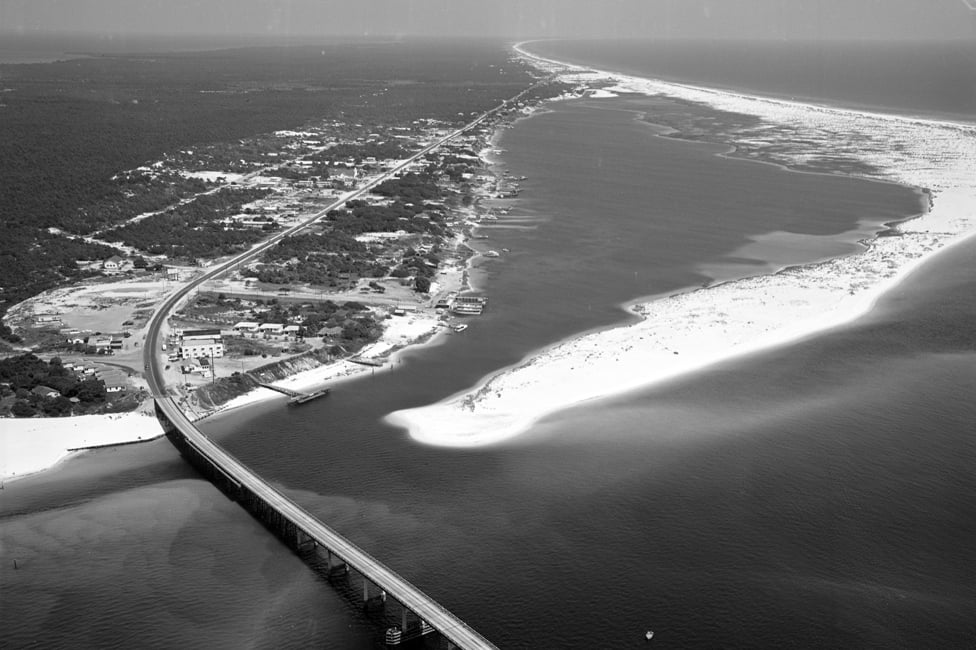Gateway to a Bright Future
Roadwork expected to stimulate investment on Tallahassee’s south side

The Airport Gateway Project is a multimillion, multimodal transportation network that, when complete in 2030, will connect the Tallahassee International Airport, downtown Tallahassee, the area’s colleges and universities, and Innovation Park, the city’s research and development district. It will include some seven miles of improved roadway and over 13 miles of new sidewalks, trails and bicycle lanes. It will also enhance both traffic and pedestrian safety while featuring improved aesthetics for residents, businesses and visitors.
“The Tallahassee International Airport is in the southern part of Tallahassee and Leon County, and it doesn’t have the best access today to our universities and downtown,” said city manager Reese Goad. “That’s been a need for many, many years. Now, we have the opportunity to connect all of these resources.”
The Airport Gateway Project is being managed by the Blueprint Intergovernmental Agency, a special body that was created in 2000 to implement projects that are funded by a one-cent sales tax. The levy has been subjected to a referendum vote more than once and, most recently, was reauthorized through 2040.
“Blueprint is under the vision and direction of the Intergovernmental Agency Board, which comprises all the city commissioners and mayor, and all the county commissioners,” explained Blueprint director, Autumn Calder. “They approve the projects and give direction on their implementation. My job is to implement the Blueprint infrastructure projects.”
Calder works with a staff of 27 people and also hires consultants to help with planning concepts, project design and the permitting process leading up to the hiring of construction contractors.
Twelve percent of revenue generated by the penny tax goes to economic development projects and programs overseen by the Office of Economic Vitality.
Calder cited a close relationship between large-scale infrastructure projects and the work of OEV.
“We recognize that when we make these infrastructure improvements in the community, the private sector responds,” she said. “Cascade Park, built in 2014, was a $35 million project; immediately following its opening there was private sector development of over $350 million. So we were able to see a tenfold impact from an infrastructure project that otherwise might not have occurred. It used to be a fenced-off brownfield, and now it’s one of the biggest attractions and destinations in the community.”
“We know that private investment follows public investment,” Goad echoed Calder. “There’s already a lot of speculative interest in terms of people wanting to invest in and around the airport but also along the corridors. Those discussions are happening; people are inquiring, trying to ready themselves for that potential.”
Goad projects that private investment in the airport area and along improved transportation corridors will run into the hundreds of millions of dollars.
He stressed that community input has been a focus since the project’s beginning and will continue throughout. Blueprint supplies updates on project phases and impacts to community leaders and advocates, local neighborhood associations, churches, organizations, area elementary schools, neighboring businesses and residents.
Calder noted that Blueprint has a citizen’s advisory committee that is kept apprised and updated.
“We have project meetings where we discuss modifications, and we’ll continue to have community discussions as the project moves forward,” she said.
That being said, both administrators also recognize that over the next several years there will be some difficult challenges in the lives of some residents and to the operation of some businesses along the reconfigured routes.
“When you have road projects that go through developed areas, you always have to be concerned about the disruption to the areas, themselves,” Goad said. “There will be property acquisition, relocation of businesses, some relocation of homes; those are always difficult. But I feel confident that we have the right processes and policies in place.”
Goad and Calder are certain that benefits to the affected areas will be more than compensatory.
“Public investment brings positive change — quality of life improvements such as better stormwater management, remediation of environmental hazards, improvements to pedestrian and bicycle safety, better transit service accessibility,” Calder said. “That in turn brings the type of improvements that people want to see in their neighborhoods. For example, Airport Gateway includes construction of a new park in the Providence neighborhood, and property values increase when they’re adjacent to improvements like parks and greenways.”
Goad sees the Airport Gateway Project as unlocking the potential of Tallahassee’s south side, which historically has been modestly invested in by both the public and the private sectors. The project will complement the city’s plans for the Frenchtown/Southside Community Redevelopment Area (CRA), 1,858 acres of residential, office, commercial/retail, industrial and green/open space close to downtown and adjacent to both Florida State University and Florida A&M University.
“Often, when you’re building roads, the only real measure is the transportation network,” Goad relates. “I think that may be secondary in this case. I think it’s the economic lift this will provide in terms of investment and jobs that is primary. This is really going to connect that CRA district to the airport, and the potential this brings is very exciting. The airport, the universities, downtown — they all of a sudden come into clear focus and are made more cohesive.”
Since inception, the price tag for the Airport Gateway Project has grown. Today, Calder pegs it at about $118 million for planning, design, permitting and construction. Most funding is coming from the penny sales tax. The Florida Department of Transportation is also contributing funding, and additional assistance is coming in the form of land grants and amenities from FSU.
Phase one construction will begin next year with 1.2 miles of new roadway linking Orange Avenue to Stuckey Avenue through FSU’s southwest campus area near Innovation Park. In addition, 1.73 miles of Springhill Road will be enhanced in order to establish a primary gateway from the airport to downtown Tallahassee.
“It began 10 years ago,” Goad said, “but it’s coming into focus now and getting close to moving forward with construction. We’re very encouraged by that.”
Design: Q2 2022 – Q4 2026
Right-Of-Way-Acquisition: Q2 2024 – Q2 2028
Construction: Q2 2024 – Q4 2030
Project Segments

Map by Scott Schiller
SEGMENT A
South Lake Bradford Road from Capital Circle SW to Orange Avenue
Segment B
Orange Avenue from South Lake Bradford Road to a new proposed roadway
SEGMENT C
New Roadway from Orange Avenue to Levy Avenue
SEGMENT D
Stuckey Avenue from Iamonia Street to North Lake Bradford Road, Levy Avenue from Innovation Park to North Lake Bradford Road
SEGMENTS E and F
Springhill Road and North Lake Bradford Road from Orange Avenue to Gaines Street
SEGMENT G
Springhill Road from Capital Circle SW to Orange Avenue
UNIVERSITY GREENWAY TRAIL (not pictured)
The University Greenway Trail is a 1.2-mile long shared use path with a 10’ wide prepared surface.


